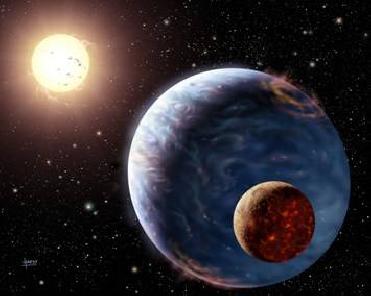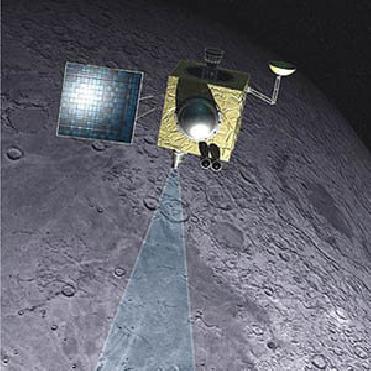
An Artistic image of 'exomoons'
Exomoons is a term referred to a smaller natural satellite. They are also known as extrasolar planet and extrasolar body.
It is difficult to find planets around other stars because the light from the star is so bright that the glare drowns out the light reflected from the planet. It's like trying to see a lighted birthday candle placed in front of a search light. So, the only way to detect extrasolar planets at this time is to measure their effects on their parent stars.
There are two ways in which planets affect their parent stars: They tug on the star as they orbit it, and they can dim the light from the star if they pass directly between the star and our field of view (eclipsing part of the star's light). The effects of these planetary motions on the star can be detected from Earth by three methods:
Astrometry - measuring the star's precise position in the heavens
Doppler spectroscopy - measuring the wavelength spread of light emitted from the star
Photometry - measuring the intensity or brightness of the light emitted from the star.
It is likely, however, that earth-sized moons of larger gas giants could have conditions suitable for organic life. Even smaller moons could be candidates. In our own system, Jupiter�s moon Europa likely has a liquid water ocean under its surface ice crust � complete with alien creatures swimming around. In fact, life-bearing moons may vastly outnumber life-bearing planets.
Kepler Mission:
Kepler is a space telescope designed to detect exoplanets. Its mission will have it orbiting the Sun for 3.5 years, after which we'll be able to tell if any of our neighboring stars actually have planetary systems around them. However, apparently we will be able to detect not only exoplanets, but also exomoons orbiting those exoplanets.
Kepler's mission was to monitor some 100,000 stars from its position above Earth's atmosphere. There, Kepler would avoid the blurring effect that the atmosphere causes in Earth-based telescopes, the interruptions caused by seasonal weather, and the cycle of days and nights to make highly accurate brightness measurements. After many delays the Kepler spacecraft was launched on March 7, 2009.
The Kepler team came to that conclusion after running a computer simulation which found that the telescope was sensitive enough to detect the gravitational pull of an orbiting moon . This means that the data expected by the end of the mission is going to be very rich, and it is said that moons as small as 0.2 times the mass of earth could be detected.
Courtesy:-
NASA
How Stuff Works
 Previous Article
Previous Article Next Article
Next Article













The Indian Air Force, in its flight trials evaluation report submitted before the Defence Ministry l..
view articleAn insight into the Medium Multi-Role Combat Aircraft competition...
view articleSky enthusiasts can now spot the International Space Station (ISS) commanded by Indian-American astr..
view article